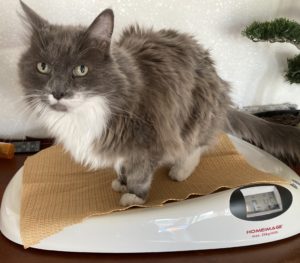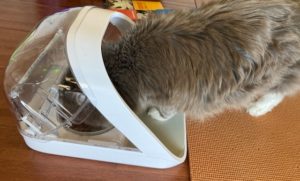
Feeding the older, skinny cat can be a challenge. Older cats do not digest food as efficiently as younger ones and can require more calories. Due to disease and natural aging processes, the older cat often suffers from a reduced appetite. Reduced appetite means that less food is eaten. Less food eaten means the cat will lose weight and muscle mass.
Reduced appetite in the older, skinny cat can be due to:
- Chronic kidney disease which can cause nausea
- Pain due to dental disease or arthritis
- Decreased odor and taste sensitivity (part of the aging process).
How can you get your older, skinny cat to eat better?
- Offer a palatable food with the appropriate nutrients
- Feed her in a way that mimics a cat’s natural behavior
- Use appetite stimulants if necessary
palatable, nutritious food
“Senior” Diets
A recent study by researchers at Oregon State, Colorado State, and University of California, Davis found that the only difference between commercially available “senior”diets and the adult diets was that there was higher fiber in the senior diets. So find an adult food your cat likes – preferably one that has been evaluated in a feeding trial.
A therapeutic diet may be recommended by your veterinarian if your cat has kidney disease or another medical condition.
“Aging Cats Prefer Warm Food”
Ryan Eyre and colleagues investigated the effect of temperature on how much older cats eat. Thirty-two cats between 8 and 14 years of age participated in a “two bowl” study of a chunks and gravy food at different temperatures. The food was refrigerated or heated as needed to 43° F , 70 °F and 98 °F.
In a series of trials, each cat was presented with one bowl of colder food and a second bowl of warmer food. The amount of food consumed by the cats was recorded. The researchers also measured 1) thickness of the gravy at the different temperatures and 2) the volatile compounds released when the food was heated.
What they found:
- There was no change in gravy thickness with temperature, so the texture of the food remained the same.
- Heating increased the release of volatile compounds associated with a “meaty” flavor
- Heating decreased the amount of volatile compounds that give rise to scents like orange peel
The cats preferred the warmer food in each of the pairs tested. They overwhelmingly preferred the food heated to 98 °F.
Other reasons cats may like warmed food:
- The warmest food had a temperature similar to the prey a wild cat would eat – so maybe a little bit of instinct is at work here.
- Heat is thought to activate taste receptors. Cats are thought to have about 470 taste buds and have taste receptors that detect salt, sour, bitter, and umami (meaty). So, heating food may also make it more palatable to cats by making it taste more “meaty”.
Heat your cat’s food before serving it – make sure to test before feeding. It should be “baby bottle” warm
Feeding your older, skinny cat: mimic natural feeding behavior
- Feed small meals frequently
- Use food puzzles to engage the cat in foraging behavior
- Put food out in different locations
- Consider elevated feeding stations for arthritic cats

Reduce inter-cat stress in multi-cat households
- Cats prefer to dine alone so have multiple feeding stations
- Make sure that more dominant animals do not keep the older cat from eating
- Investigate strategies to protect your older, skinny cat’s food – for example, consider a microchip feeder
medical intervention – appetite stimulants
- Mirtazapine: Tetracyclic antidepressant that stimulates appetite in cats. Mirtazapine comes in pills and a transdermal ointment called mirataz. Mirataz is FDA-approved for cats.
- Capromorelin stimulates the production of Ghrelin, a hormone your stomach produces and releases. It signals your brain when your stomach is empty and it’s time to eat. Capromorelin (Elura) comes in an oral liquid for once daily administration. It was developed to manage weight loss in cats with Chronic Kidney Disease.
Make sure your old cat eats – fasting longer than 2-3 consecutive days can result in hepatitis lipidosis, which can be fatal if not treated promptly
Keeping your older, skinny cat well-fed is essential to maintaining a good quality of life for him or her.
Warm canned food
Feed small meals frequently
Talk to your vet about an appetite stimulant if necessary.
Want to keep up with the world of cats? Subscribe to The Feline Purrspective!

